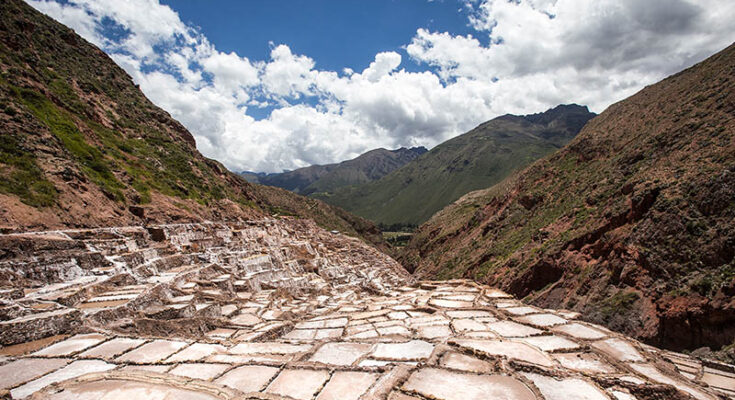The Saltpans of Maras are famous for their salts terraces built on a mountain slope. But, did you know that you can visit them like a local and spend a day there which will be very different from the experiences offered by traditional travel companies? Below we tell you how.
At Maras there are 4400 salt pools which date from the pre-Inca period and now belong to the 420 local shareholders. The Maras Saltpans are a great success. The entrance fee to these beautiful saltpans reflected in the Andean sun is S/10 soles, and the money collected is shared among all the shareholders. And the salt production itself also provides the community with an income, particularly from April to November, when production is at its height.
For those travelers seeking a trip which involves more than taking a great selfie, and who would like to share an experience that will teach them a little more about local culture, the Media Luna community, situated in Urubamba, has just the thing. Take a minivan or shared taxi from Cusco as far as the bus station at Urubamba, and from there a motorcycle taxi to the community. There, after passing one of the valley’s most luxurious hotels, the Belmond Río Sagrado Hotel, you’ll find the little houses of the 145 families who make up the Media Luna community. First, you’ll walk to the saltpans with Señor Tiburcio, who has 10 pools. The walk is quite steep and will take you around one hour to complete (500 meters on level ground, a 2 kilometer long ascending trail). The tour can be tailored to your interests. Tiburcio knows every corner. You’ll return along the same trail, downhill this time. You’ll pass through the village of Pinchingoto, cross the Carachaca Bridge, chatting all the time with Tiburcio, who wears traditional clothing, including a bright waistcoat. Tiburcio only speaks Spanish, but you can ask for a translator if you need one.
You’ll arrive just in time for lunch at Nancy’s local restaurant. This is a simple place, although the décor is tasteful and you’ll be served an excellent family-style meal. On this occasion, we were served a homemade corn soup and a creamy and delicious tarwi-based main dish.
After lunch, you’ll be invited to learn more about the local way of life. Each participating family has organized their house as a place where visitors can witness for themselves the community’s daily activities. Together with her children, Mercedes welcomes guests in her small living room, and demonstrates her textile making skills. She has an old pedal loom which guests are welcome to try out. She will be happy to show you the most commonly used technique, which involves the use of a back strap loom, and she will teach you about natural dyes. Mercedes also offers her weavings for sale. At another house, Gertrude will invite you to visit the guinea pig corrals. The breeding of guinea pigs (a great delicacy for local people) is practiced by many families throughout the area. Carmen, who has won prizes for the corn beer she produces, will explain to you how corn beer is made and invite you to try some chicha and frutillada (strawberry chicha). You’ll be welcome to drink an entire glass, but remember that this fermented drink is pretty potent! Her grandchildren accompany Carmen, wearing their typical costume and always curious to speak with visitors. The last one to receive you in her house will be Ysabel, who will explain how medicinal plants are used and show you her garden. All these houses are situated on the edge of the Urubamba-Ollantaytambo road, in a row. You don’t need to go far to find people who keep their traditions alive.
The full day, including the walk to Maras, lunch and the visits to local houses and workshops begins at 9:00 a.m. and ends at 4:00 p.m. The cost is S/132 soles. You can also choose to just visit the workshops, but we recommend the full day experience. Local transport and entrance fees are not included.
Bookings are accepted for Tuesdays, Thursdays, Saturdays and Sundays via turismorural.ml@nexosvoluntarios.org, or you can call (+51) 993 187 192.
Please note:
– December to March is the rainy season and the pools are not used. If you visit at this time of year, they will be earth colored, rather than gleaming white.
– The most important annual fiesta in Maras is held May 3rd. This is Cruz Velacuy, when the spring from which the salt water emerges is honored.



